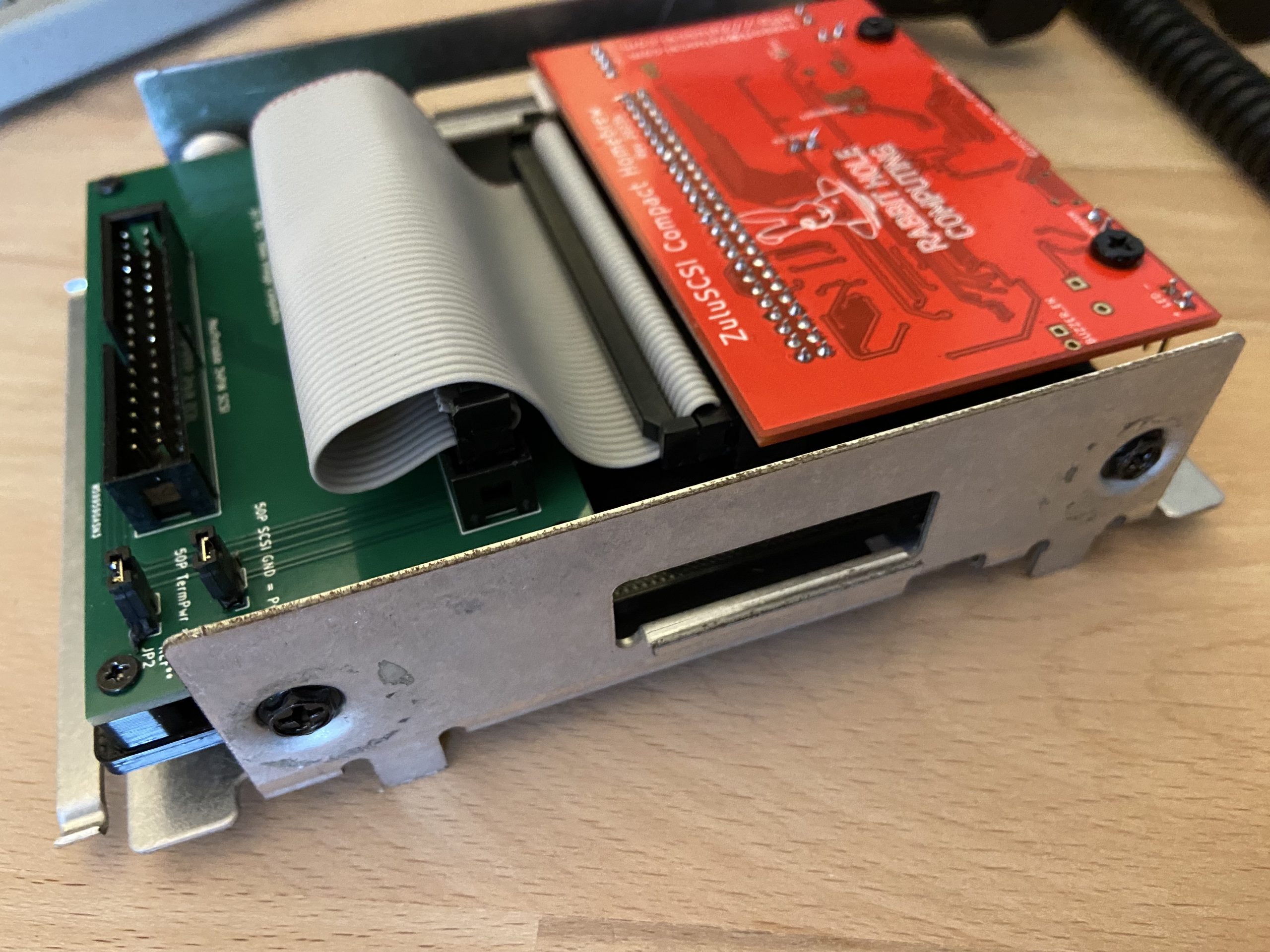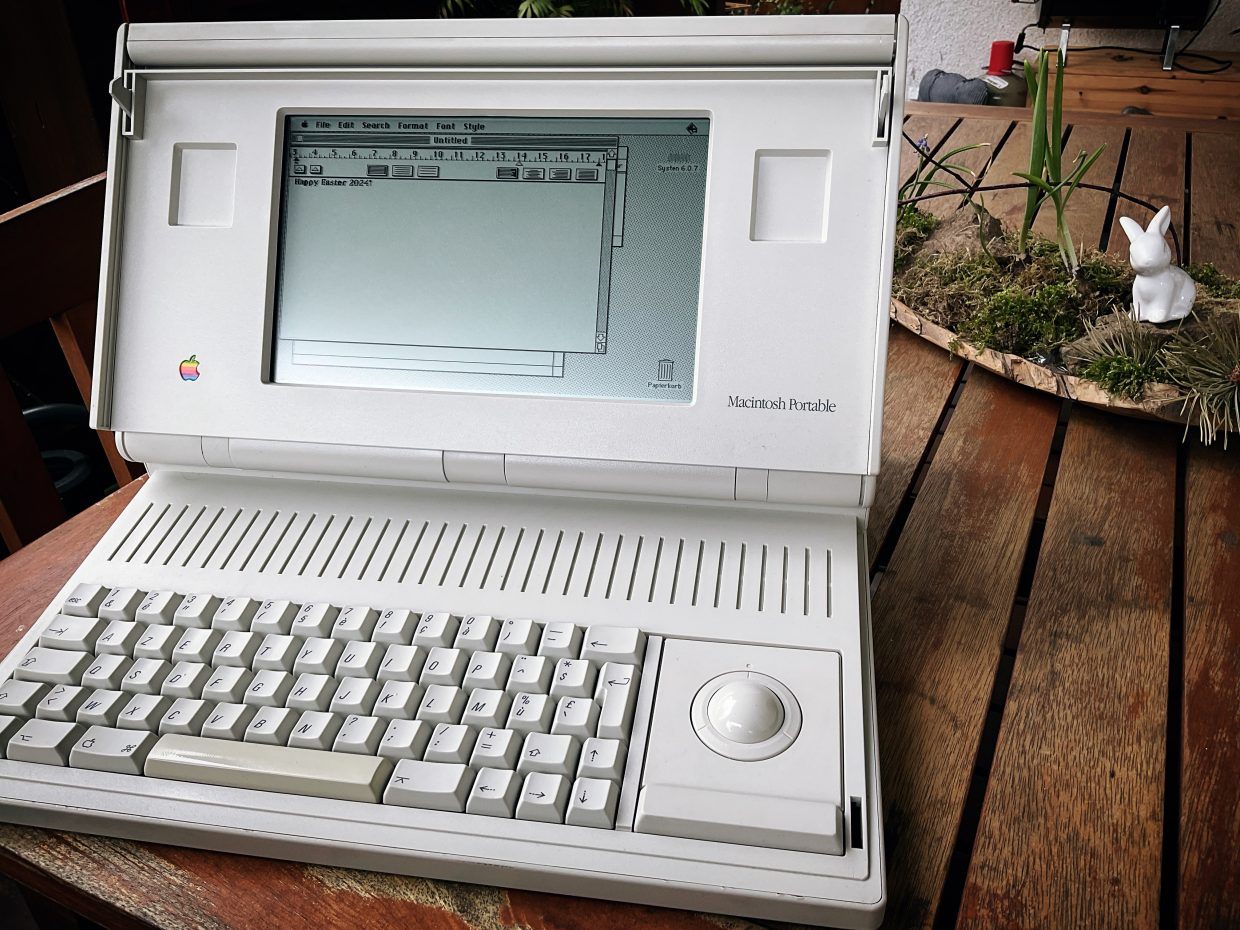The Macintosh Portable 5120 released in 1989 and sold until 1991, was Apples first attempt to offer a portable, self contained, battery powered machine. Until then, the only „mobile“ option were the classic All-In-One Macintoshes with the optional carrying bag that was geared towards students who would lug their machines from home to campus and back again.
The Portable had a lead acid battery allowing off-grid operation for about 10 hours – which back in the day was an excellent runtime – and it had a built in keyboard and trackball as well as a very crisp black and white active matrix LCD display.
The machine was not really successful though due to its high price tag, delays with the launch date and several design issues:
- Due to the size of a portable typewriter and the weight of about 7kg it was not exactly mobile. The heavy lead acid battery and the 3.5″ hard-drive contributed to the weight quite significantly
- The display was not backlit, making hard to read in low light. Apple addressed this issue with the later 5126 backlit model and even offered an upgrade kit for the original system.
- The computer only had 1MB of memory. Memory expansion options were available from Apple and other vendors, however, at steep price tags, making the whole package very expensive.
The Portable features some highlights, though which set it apart from other offerings of the same vintage:
- Its battery runtime of the lead acid battery is unparalleled, it however requires proper maintance and the machine cannot run on AC power alone.
- The active matrix LCD is crisp and without smearing or ghosting, making it a much better option than the contemporary passive panels.
- The built-in keyboard is a joy to type on, its mechanical with SKCM ALPS switches giving excellent tactile and acoustic feedback.
- The position of the keyboard and the built-in trackball can be easily swapped, making it ambidextrous and thus useful for left-handed users as well. Furthermore, the trackball can be replaced with the numeric keypad for accounting and number-heavy applications.
- It was as fast as the fastest prior Mac due to its 16MHz 68k processor, running twice the speed of a classic Mac. SRAM memory allowed for a standby mode out of which the machine resumed execution instantly at exactly the point where it left off.
Today, the keyboard is where this computer shines. It is a joy to type on it, and with a 8MB memory expansion card it can run up to System 7.5.5
My Mac Portable
My Portable came from a seller in France, it therefore has the french keyboard layout. The standard trackball is installed, I do not have the extra keypad.
The machine came without a battery, so I rebuilt one out of a 6v „lantern battery“ installed in a 3d printed case, which works quite well. I recharge it outside of the machine with a lead battery charger since the power circuitry in the Portable has some issues which were partly solved by a motherboard recap and replacing the hybrid module.
The built in SCSI harddrive was totally dead as is the case with many vintage harddisks. I ultimately replaced it with a ZuluSCSI homebrew and a selfmade adapter from the proprietry 34pin to standard 50pin SCSI. I used a blueSCSI previously but had issues with it.

I also found a 2MB memory expansion card on ebay, bumping up the RAM to a total of 3MB which is sufficient to run System 7.0.1
Mac Portable Overview
| This Portable | Original Spec | |
| CPU | – same – | Motorola 68HC000@16MHz, no FPU |
| Memory | 3MB | 1MB, soldered on the mainboard Expandable up to 9MB via proprietry module |
| Fixed Disk | ZuluSCSI w. SDCard | 40MB SCSI 3.5″ (Apple 40SC) |
| Removeable Media | – same – | 3.5? High Density |
| Video | – same – | 640×400 1bit mono, 10.1? active matrix LCD |
| Audio | – same – | 8bit mono, built in speaker, headphone and mic jack |
| System Software | 7.0.1 | Original 6.0.4, supports up to 7.5.5 |
| Released in | 1989, replaced 1991 by the backlit 5126 withdrawn 1992 succeeded by the PowerBook 100 | |
| Price at release | USD 6,500 ~ USD 16,650 in 2024 |
Links to other machines in my collection
- PowerBook 145B Restoration – a later 100 series PowerBook which succeeded the Portable
- IBM PS/2 Portable Restoration – IBMs PS/2 P75, a portable computer of similar vintage
- Toshiba T3200 – the „spacesaver“ – a portable, Intel based computer of similar vintage
Sources and References
Page Visits: 61226
